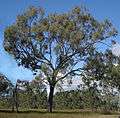Eucalyptus crebra
| Eucalyptus crebra | |
|---|---|
 | |
| Scientific classification | |
| Kingdom: | Plantae |
| (unranked): | Angiosperms |
| (unranked): | Eudicots |
| (unranked): | Rosids |
| Order: | Myrtales |
| Family: | Myrtaceae |
| Genus: | Eucalyptus |
| Species: | E. crebra |
| Binomial name | |
| Eucalyptus crebra F. Muell. | |
| Synonyms | |
|
Eucalyptus drepanophylla F.Muell. ex Benth. | |
Eucalyptus crebra, commonly known as the narrow-leaved ironbark or narrowleaf red ironbark, is a type of Ironbark tree native to eastern Australia. A member of the large genus Eucalyptus, this tree is in the Myrtaceae family and can grow to a large spreading tree up to 35 m (115 ft) high. It is an important source of nectar in the honey industry and its hard, strong timber is used in construction.
Taxonomy
The Narrow-leaved ironbark was originally described by Victoria state botanist Ferdinand von Mueller in 1859.[1] The specific epithet is the Latin adjective crebra "crowded" or "close together".[2] Within the genus Eucalyptus, it belongs in the subgenus Symphyomyrtus.
Description
This plant is a large spreading tree, which may reach 35 m (115 ft) in height. The rough furrowed bark is grey mottled with yellow and orange. The tree's name ironbark stems from the rough and unyielding texture of the cambium on the outmost layer of the plant. In the early days of colonization wood felling was achieved with axe and saw, ironbark stands usually meant a broken ax head.
The narrow lanceolate leaves are a uniform greyish-green in colour and measure 7–15 cm (3–6 in) in length by 0.9–1.7 cm (0.35–0.67 in) wide. The small white flowers appear from late autumn to spring, and are followed by small pods.[3]
Distribution and habitat
The Narrow-leaved ironbark is found in eastern Australia, from Picton southwest of Sydney north through New South Wales and Queensland to the vicinity of Cairns.[2] It grows on sandier soils.[4] The narrow-leaved ironbark is one of the key canopy species of the threatened Cumberland Plain Woodlands.[5]
Ecology
Koalas can consume the leaves, and the flowers are pollinated mainly by insects. The southern or shady side of the trunk is habitat for lichens.
Uses
The tree has a hard, strong, and dark red timber, which has been used for sleepers and construction.[2] A plank has been recorded as being used for Elizabeth Farm, Australia's oldest surviving European dwelling.[6] It is used as a shade tree or to line roadways, and is also available as a cultivar. It is useful in honey production as the flowers are heavy in nectar and pollen;[2] the resulting honey produced by bees is light-coloured and delicately flavoured.[7]
Gallery
 E. crebra open capsules.
E. crebra open capsules. E. crebra open capsules.
E. crebra open capsules. E. crebra in coastal Central Queensland.
E. crebra in coastal Central Queensland. E. crebra bark
E. crebra bark
References
- ↑ "Eucalyptus crebra F.Muell.". Australian Plant Name Index (APNI), IBIS database. Centre for Plant Biodiversity Research, Australian Government.
- 1 2 3 4 Elliot, Rodger W.; Jones, David L. (1986). "Eu-Go". In Elliot, Rodger W.; Jones, David L. Encyclopaedia of Australian Plants suitable for cultivation. 4. Lothian Publishing. pp. 66–67. ISBN 0-85091-213-X.
- ↑ Botanic Gardens Trust. "Eucalyptus crebra". Royal Botanic Gardens website. Royal Botanic Gardens, Sydney. Retrieved 2009-06-21.
- ↑ Hill, Ken (1999). "Eucalyptus crebra F.Muell.". PlantNet - New South Wales Flora Online. Royal Botanic Gardens & Domain Trust, Sydney Australia. Retrieved 2009-06-21.
- ↑ Department of Sustainability, Environment, Water, Population and Communities (20 June 2011). "Cumberland Plain Woodlands". Australian Government. Retrieved 7 September 2011.
- ↑ D'Hub (Design Hub). "D6911 Timber specimen (plank), Ironbark (Eucalyptus crebra), used in the building of stables at Elizabeth Farm, Rose Hill, New South Wales, Australia, 1793". D'hub - Your online design resource. Powerhouse Museum, Sydney. Retrieved 2009-06-24.
- ↑ Capilano Honey (2006). "Floral Varieties". Capilano Honey. Capilano Honey. Archived from the original on May 5, 2009. Retrieved 2009-06-24.